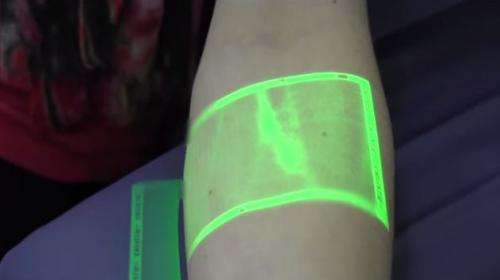November 3, 2014 weblog
Near-infrared technology plays role in visualizing veins

Having hard-to-find veins is never a pleasant thought if anticipating donating blood. Now the Australian Red Cross Blood Service has a message to potential donors that such unpleasant thoughts should not stop them from making the move to save lives. The service has announced it is conducting research into the use of technology to visualize blood donors' veins during blood donation. Angela King, Blood Service researcher, said they are placing the technology in a trial study to determined its effectiveness.
Who is the vendor? The promotional video and report from the service refer to the "technology" but do not name any specific vendor. The report said, "The assessment will involve two different devices available from Australian providers." Some of the questions seeking answers will be, Does the procedure reduce anxiety, improve the donor's comfort, and make the donor more likely to donate again? "It is important for the Blood Service to recruit young donors in order to have a sustainable blood supply for the future," said senior researcher, Dr. Dan Waller. "We are interested to see if this technology improves the donation experience in young people and whether that increases their likelihood to return to make repeat donations." The study will help the Blood Service decide whether the technology should be rolled out for use. Comfort is not the only measure; important measures will be safety and efficacy and costs. "When the study is completed we will have a lot more information to guide these decisions." The trial will involve 900 donors, of which 300 will be first-time donors and the remaining 600 will be return donors, between ages 18 and 30.
Non-invasive near infra-red technology is at play here; an image of the veins is projected onto the skin's surface. Veins have a lot of deoxygenated haemoglobin that absorbs near infrared light; the device uses this information to project the image. Machine settings manage individual differences.
But is the technology safe? In a Service-posted Q&A with Dr. Waller, he said, "The light should not be directed at the eyes and the manufacturers' advice is to use caution in people with impaired blink reflexes." At the same time, "The technology is used in other clinical and hospital settings and has been proven to be safe." He said that the Blood Service would not trial this technology if they thought there was a risk to the safety of its donors. "The results to date have been closely monitored and it does appear safe." Waller, one of the senior investigators on the trial, said staff found it especially useful on donors whose veins were not visible to the naked eye. According to the announcement, results of the research "so far" were to be presented at a conference in Philadelphia.
More information: www.donateblood.com.au/media-c … trial-is-not-in-vain
© 2014 Phys.org


















